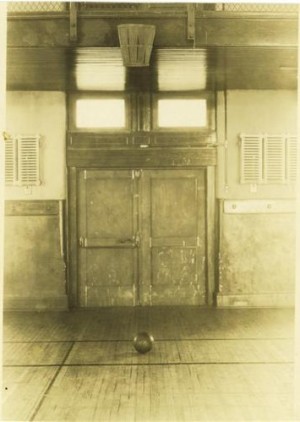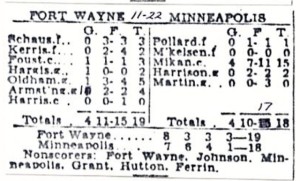Regardless of how you feel about basketball, you’ve got to appreciate the way it can bring groups of strangers together to share moments of pure adulation and collective defeat. Case in point: the buzzer-beater:
You know this moment: time is running out, the team is down by one, a player arcs the ball from downtown just as the buzzer sounds—and sinks it. it’s exhilarating. It’s heartbreaking. And most of all, it’s good design. But it’s not the way basketball was originally designed.

The invention of basketball is credited to James Naismith, a phys ed instructor who had the idea to mount peach baskets to the walls of a Springfield, Massachusetts gymnasium, and have his students attempt to throw a leather ball through them.
After points were earned, the game was put on hold until someone could retrieve the ball with a ladder.
Eventually, the bottomless basket became the standard, and early 20th Century basketball became a speedier game than in the 1890s. But watch any game from as late as the 1950s and it still seems dreadfully slow compared with how the game looks today.
Here’s what’s missing from the basketball of yore: the shot clock.
During pro basketball’s infancy in the 1950s, nothing forced a player to shoot the ball. If a team was winning, and they wanted to keep their lead, the team could literally hold on to the ball for ten minutes and run the clock out.
The game may not have seemed slow to the players, but it wasn’t a particularly compelling spectator sport. Especially when you had games like the November 22, 1950 bout between the Ft. Wayne Pistons and the Minneapolis Lakers, which had a final score of 19-18.

Fast forward to 1954. Enter Danny Biasone, owner of the Syracuse Nationals. Biasone had crunched some numbers, and he believed that some simple arithmetic could save basketball.
By this point, an exciting game of pro ball would have teams scoring 80 or more points—a score that Biasone figured was high enough to retain the audience’s interest. Biasone started tracking how many shots a team needed to make to score the requisite 80-something points, and he found that each team needed to take an average of 60 shots per game.
So given…
60 shots per game x 2 teams = 120 total shots per game
And…
One game = 48 minutes = 2880 seconds
Thus, divide the number of shots needed by the length of the game…
2880 seconds per game / 120 shots
And you get…
24 seconds per shot
Therefore, Biasone reasoned, an exciting game of basketball needed a team to take shot every 24 seconds. To hold players to that standard, Biasone instituted a 24-second shot clock, and a new rule to go with it—if a team doesn’t take a shot by the time that clock runs out, it’s a violation and they lose possession of the ball. No more running the clock for minutes at a time.
There’s any number of reasons a basketball fan can love the sport—the pace, the intensity, the sheer athleticism of the players—but it just might be that they all take root in that tiny, nearly invisible 24-second shot clock.

Danny Biasone was posthumously inducted into the Basketball Hall of Fame in 2000. Basketball legend Dolph Schayes, who played under Biasone’s leadership on the Syracuse Nationals, offered a tribute at the ceremony.
Reporter Eric Mennel spoke with Dolph Schayes—who played pro basketball both before and after the advent of the shot clock—about how Biasone’s contribution to the game shaped basketball into what it has become today.
A different version of this story aired previously on BackStory with the American History Guys, where Eric is a staff producer.



Leave a Comment
Share